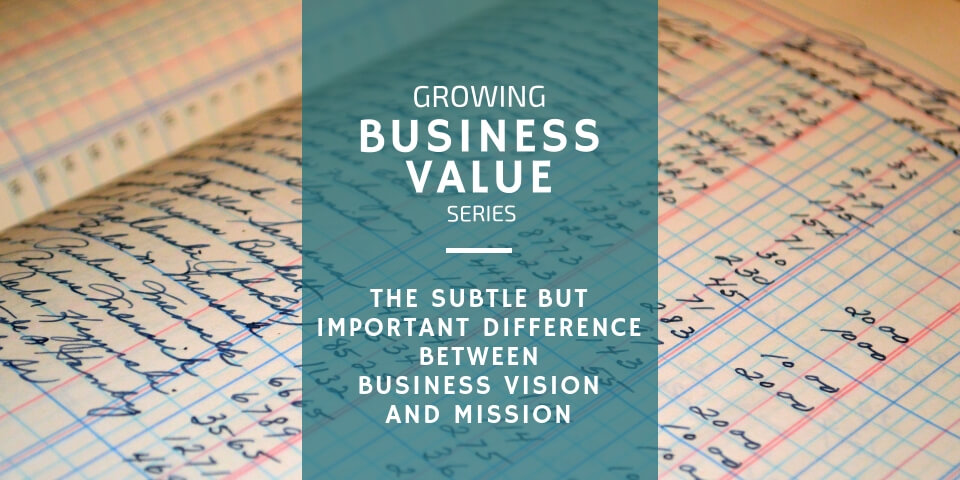
The Strategic Planning Process: Steps to Clarity and Direction
December 3, 2018
How to Start a Small Business at Home: The Complete Guide
December 6, 2018Understanding The Difference Between Business Vision and Mission

In our Value Growth Series, I’ve identified 8 fundamental areas of your business that can drive up its intrinsic value. I’ve told you that strategic planning is the type of planning you need to do to positively affect the value of your business. In this article, I’ll begin reviewing the pieces of the strategic planning framework. Specifically, I’m going to talk about the difference between business vision and mission, and how they affect your business’s long-term outlook.
Podcast Time Index for “Vision vs. Mission in Strategic Planning”
00:35 – Strategic Planning: Vision vs. Mission
01:01 – Planning for the future
04:28 – What is the Vision
04:51 – What is the Mission
05:42 – Vision vs. Mission
09:04 – Know where you’re headed
10:57 – Summary
Plans for the Future
Charlie “Tremendous” Jones, famed businessman and author, once said, “You will be the same person in five years as you are today except for the people you meet and the books you read.” When I was little, my mother heard this saying and adapted it a little bit. She used to tell me, “Son, where you’ll be five years from now is determined by the books you read and the people you associate with today.” Well, both Charlie and my mother realized that people can plan for the future. We can cast a broad idea for what we want to accomplish and make it happen.
Feeling overwhelmed by strategic planning? Our downloadable Strategic Planning Worksheet can help!
Since we’re dealing with strategic planning, I’d like to modify Mr. Jones’s words and my mother’s saying. I’d say that where your company will be in five years is dramatically affected by the strategic planning you do today. No matter how you say it, the outlook is vital.
What Are a Business’s Vision and Mission?
You recognize the words “vision” and “mission.” If you remember, they’re the first two words in our strategic planning framework acronym – VMVSOSTA. And honestly, if you’re like me, you probably roll your eyes when you hear the terms vision or mission. I get extremely aggravated with these terms because many times “consultants” charge ridiculous amounts of money to help business owners create vision and mission statements. Typically, these business “consultants” spend all their time discussing the importance of casting a vision and communicating a mission. Yet, they fail to help business owners solve problems or grow their businesses using the vision and mission statements.
However, if you create vision and mission statements within your strategic planning framework, you can use them to drive your team forward toward achieving results. You can create strategies and implement actions that will make your business into what you want it to be.
Now, what exactly is vision? Well, a vision statement is a company’s roadmap, indicating both what a company wants to become and what it’s going to take to get it there. Although similar, a mission statement is different. Rather than outlining where your business is going, the mission statement explains the reason why you’re going.
Vision Vs. Mission
To better explain vision and mission, let me give you some vice versa scenarios.
- A vision is aspirational, while a mission is inspirational.
- The vision paints a seductive picture of how you want the future to look, whereas the mission gives the reason why you want it to look that way.
- A vision sets a measurement for achievement, while a mission aligns and motivates your team members to achieve success.
- The vision goes into great detail, whereas the mission is concise and memorable.
- A vision is communicated internally, while a mission is communicated publicly.
Why Defining Your Business Vision and Mission Matters
So why do I tell you all this? Because you have to know where your business is headed long-term. If you’re trying to grow the value of your company, then you have to be able to articulate what growth looks like to your team members. You must have a clear, decisive vision. Then, you must explain the why behind your vision. By creating and explaining, you align your team members. You get them headed in the same direction – the direction you’ve set forth. Your vision statement shows them where to go, and your mission statement becomes the rallying cry to get them there.
Strategic planning doesn’t stop once you cast your vision and rally your team members behind your mission. Join me in my next article as I discuss how to align your vision and mission with your values.



